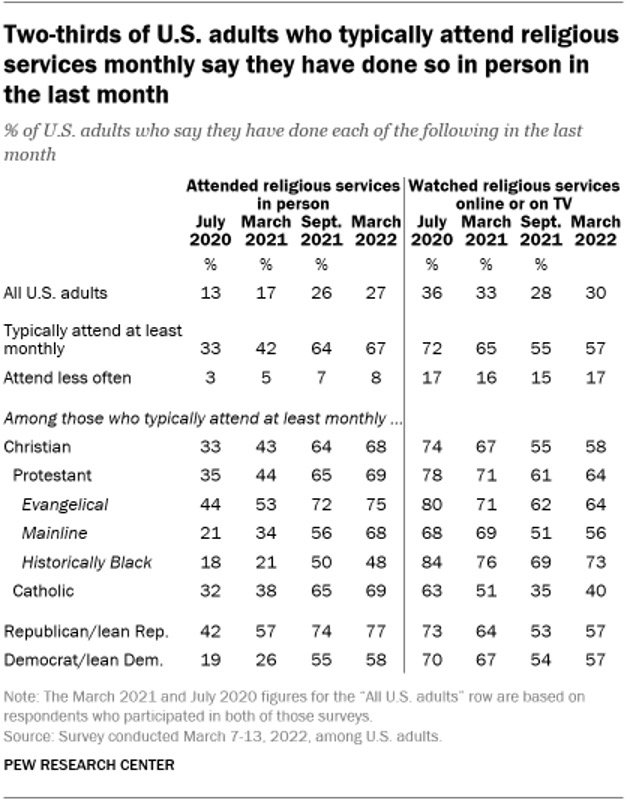They’re Not Coming Back
The latest survey from the Pew Research Center has found that about as many people who had returned to in-person services six months ago are about the same number attending now. In other words, although the situation improved in relation to all things COVID – vaccinations available, mask mandates dropped, case numbers plunged – there has been no appreciable change in the number of people who have returned.
About two-thirds (64%) had returned by September 2021, and now, in March 2022 (67%), it’s still right at about two-thirds.
As my friend Carey Nieuwhof wrote at the start of the year, “2021 had many leaders clinging to the idea that the next season — Easter, the new school year, Christmas, etc. — would bring attendance back to 2019 levels. For most churches, that ‘magic season’ never materialized.”
He's right. They haven’t come back. And they aren’t coming back. The church you now have is the church you now have.
There are several reasons why embracing this is important. First, because it will help you realize that you are not in a season of regaining your attender/volunteer base but a season of rebuilding it. It is critical for leaders to invest their energies accordingly.
Second, it will help you realize that you must embrace the hybrid model of church. Specifically, the hybrid of being both physical and digital.
Speaking in very broad terms, there are two types of churches operating at the moment: those that reopened and almost immediately scaled back on all things online, and those who have reopened for in-person services but have maintained an online constituency. (Some, such as the church I lead, go beyond merely maintaining an online presence to encouraging online attenders by offering a full online campus, which you can read in previous blogs I’ve written titled "The Most Overlooked Place to Plant a Church" and "The Importance of Affirming Online Attendance.")
The first type of church assumed that reopening for in-person services and the demise of all things COVID were all it would take for the return of pre-pandemic attendance levels. The problem, after all, was the pandemic.
They assumed wrong.
There were broader issues at hand that were simply accelerated by the pandemic. Church attendance had been in decline for some time. Further, the broader cultural realities – namely a post-Christian world and a digital revolution – had changed both the nature of our mission field and the means by which we reach it. Simply going back to a “business as usual” approach is not the solution.
Churches that went hybrid and stayed hybrid found that while in-person attendance has not returned to pre-pandemic levels, the overall attendance and health of the church has not only been maintained but has also grown. In other words, because of a hybrid model, diminished in-person numbers do not reflect an overall diminishment of the church. Further, that giving people the freedom to attend in person or online increased overall engagement with the church.
The findings of the Pew survey bear this out:
The Center’s survey finds that among all adults who say they typically attend services at least monthly, 36% have attended in person and watched services digitally in the last month…. One-in-five (21%) may still be substituting virtual attendance for in-person attendance….
While religious congregations as a whole may have experienced a large drop in physical attendance during the pandemic, there’s good reason to believe that virtual attendance is much higher today than it was before the coronavirus outbreak began in early 2020. One piece of evidence is that, in a July 2020 survey, 18% of U.S. adults said that since the pandemic began, they had watched religious services online or on TV for the first time. Combining both forms of attendance, nearly nine-in-ten people who say they are regular attenders (88%) report that they have participated one way or the other in religious services in the past month.
In addition, the share of all U.S. adults who say they have either attended religious services in person or watched online or on TV (or both) in the past month (43%) is substantially greater than the share who say they typically attend religious services at least once or twice a month (32% among all March 2022 survey respondents).
While this scenario could change with COVID’s continuing diminishment causing increased in-person attendance, or through a new outbreak resulting in decreased in-person attendance, this much we know: whatever you have in person is largely what you are going to have in person. And if you aren’t serving people in a hybrid model, in person is all you are ever going to have.
James Emery White
Sources
Justin Nortey, “More Houses of Worship Are Returning to Normal Operations, But In-Person Attendance Is Unchanged Since Fall,” Pew Research Center, March 22, 2022, read online.
Kate Shellnutt, “Americans’ Return to Church Has Plateaued,” Christianity Today, March 22, 2022, read online.
Carey Nieuwhof, “12 Trends That Will Shape the Church in 2022,” Outreach Magazine, January 14, 2022, read online.


